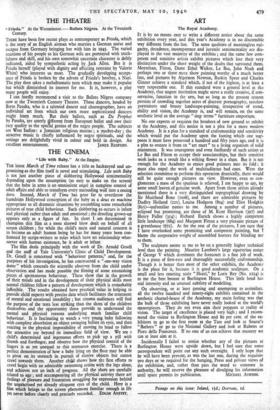THE CINEMA
"Life with Baby." At the Empire.
THE latest March of Time release has a title as hackneyed and un- promising as the film itself is novel and stimulating. Life with Baby is not just another piece of slobbering Hollywood sentimentality depending upon the assumption (so easy to make on the screen) that the babe in arms is an omniscient angel in complete control of adult affairs and able to transform every marauding wolf into a cooing dove. Instead, March of Time has gone far to overthrow the humdrum Hollywood conception of the baby as a deus ex machina appropriate to all dramatic situations by assembling some remarkable pictures of true child behaviour. Such slobbering as occurs is infant and physical rather than adult and emotional ; the drooling grown-up appears only as a figure of fun. In short I. am determined to champion this film as a most shrewd blow dealt on behalf of all screen children ; for while the child's main and natural concern is to become an adult human being he has for many years been con- demned by script-writers to roles which have no relationship what- soever with human existence, be it adult or infant..
The film deals principally with the work of Dr. Arnold Gesell and the staff of Yale University's Clinic of Child Development. Dr. Gesell is concerned with " behaviour patterns," and, for the purposes of his investigation, he has constructed a " one-way vision dome " which conceals the scientific observer from the child under observation and has made possible the filming of some astonishing pieces of spontaneous behaviour. These show that in the growth of their minds- and in the development of their physical skills most normal children follow a pattern of development which is remarkably inflexible. The results obtained have practical value in helping to provide child experts with precise data which facilitates the treatment
of mental and emotional instability; cinema audiences will find the purpose of the tests less striking than the shots of the children themselves and the opportunity these provide to understand the mental and physical reasons underlying much familiar child behaviour. It is fascinating to watch a very young baby following with complete absorbtion an object swinging before its eyes, and then reacting to the physical impossibility of moving its head to follow the attractive toy beyond its immediate field of view. We see child's determined and ingenuous efforts to pick up a pill with thumb and forefinger, and observe how the physical control of the fingers is as yet unequal to this strenuous exercise. There is a perfect demonstration of how a baby lying on the floor may be able to pivot on its stomach in pursuit of elusive objects but cannot crawl towards them. Another child shows how the first efforts to crawl begin with an admirable swimming action with the legs alone, and achieves not an inch of progress. All the shots are carefully related to age ; and accompanying all the physical activity there are feelings of pleasure and frustration struggling for expression behind the unpractised yet already eloquent eyes of the child. Here is a film which brings to the screen phenomena familiar enough in life Yet never before clearly and precisely recorded. EDGAR ANSTEY.


























 Previous page
Previous page